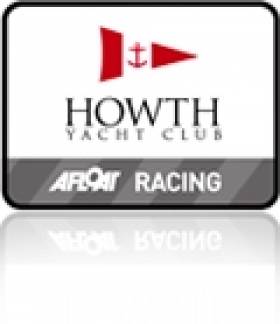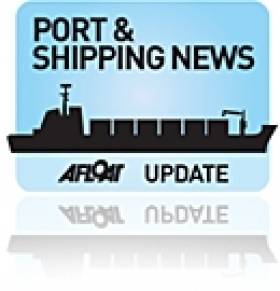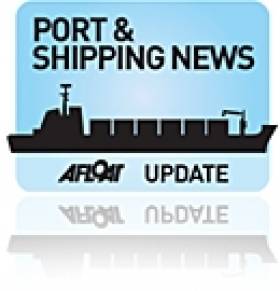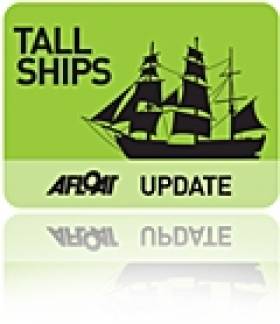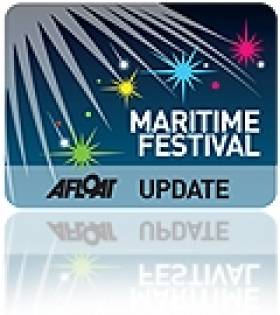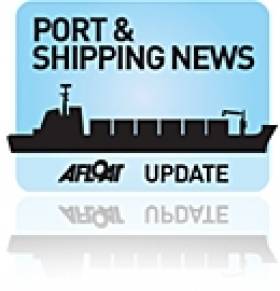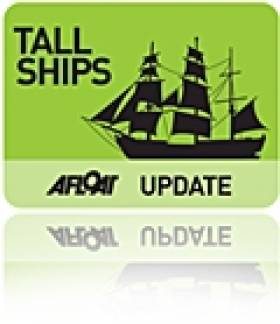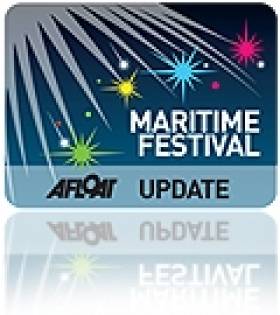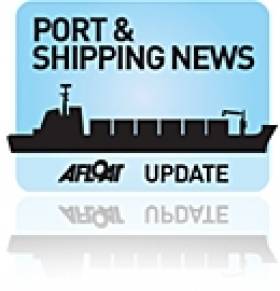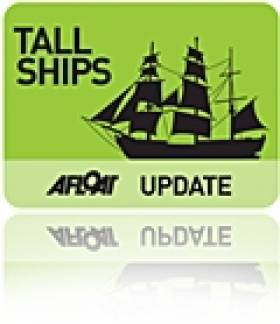Displaying items by tag: Drogheda Port
Howth to Drogheda Yacht Challenge Revival
#hyc – Howth YC Cruiser Classes are invited to race in Howth to Drogheda Yacht Challenge in conjunction with the Irish Maritime Festival and Drogheda Port. Howth Yacht Club has announced the revival of a once traditional race for all IRC cruiser-racers (and others) to the Boyne on Saturday June 20th. The race forms part of a fun-filled weekend festival that includes Tall Ships, boat races, swimming races, pirate battles, music, fairgrounds and a celebration of local foods.
'The Howth to Drogheda Yacht Challenge' is a race for cruiser-racing and non-spinnaker classes and also invites boats that might prefer a more leisurely cruise to the Boyne with an overnight in the colourful company of the multitude of visiting yachts and tall ships. The race commences in Howth Sound at 10:00, finishing in the mouth of the Boyne in the early afternoon. Entry is only €5 per boat.
Race prizes include the 'Howth to Drogheda Yacht Challenge' perpetual trophy as well as class prizes. It being an excellent distance for day-sailing, this 25 mile-long race will attract a diversity of entries from across all cruiser-racing classes, allowing keelboats ranging in length from about 25-60 foot to compete under handicap for the overall prizes. 'Parade of Sail' special prizes will also be awarded to best-dressed boats and to best 'pirate' crew.
Drogheda Port will host a lively afternoon and evening for all participating sailors including live music, food stalls, fairground, maritime art exhibition and lots more at their 2015 Irish Maritime Festival.
The post-race schedule includes:
Saturday 20th
· 15:30 Parade of Sail in Drogheda - including prizes for best dressed boats and best dressed 'pirate' crews.
· 16:30 Berthing by direction at the city quays.
· 20:00 Prizegiving BBQ at Scholarstown House, including complimentary burger and glass of wine for all competitors.
Sunday 21st
· Following a special ecumenical service in St Peter's Church, boats depart the city quays in parade from 12:00.
225th Anniversary Year of the Founding of Drogheda Port
#DroghedaPort225th –This year celebrates the 225th anniversary of Drogheda Port Company whose origins date to 19th of April 1790 when the very first board meeting was held in the town's Tholsel.
Drogheda Port Company can trace it historical roots to be that of the oldest remaining indigenous industry in the Co. Meath town having employed more than 1,700 workers over the period.
The present day port located downriver along the Boyne remains as vital now as then in the economic well-being of the region.
The company, or commissioners as they were then titled, were established by Act of King George 111 for the 'improvement of the Port and Harbour of Drogheda, and the better regulation of the Police of said town.'
It was recognised at the time that a separate company would be the best vehicle for the future management of the commercial port and would contribute considerably to the advancement of trade and prosperity.
Drogheda Port Handled Over 1.2m Tonnes in 2014
#Ports - Drogheda Port Company handled over 1.2 million tonnes of cargo in 2014, an increase of 17% on 2013.
The port outperformed the Irish port sector in terms of year on year throughput growth for the third year running. The latest national volumes indicate that the volume of port and shipping traffic through the Republic of Ireland are slowly recovering.
Against this backdrop the port's volume growth is particularly impressive. Throughput volumes for 2014 are the highest recorded since 2005 when a record throughput of 1.4 million tonnes was achieved. The total value of goods traded through the port in 2014 was over €425 million.
A number of capital investments in the port were made in 2014 by the private sector with the aquisition of new cranes. The port has invested in new warehousing to be completed in 2015 and will expand the throughput capacity of the port and its role in the region supporting export businesses.
Nationally and internationally the outlook for the sector in 2015 remains challenging but positive, notwithstanding the current uncertainty in the financial markets.
Commenting on the ports performance CEO Mr Paul Fleming said “The company is pleased to report that trade volumes are continuing to increase significantly year on year. It is quite clear from the volume growth that the economy is starting to grow again and construction industry imports are increasing. It is also extremely positive for a number of indigenous companies who are exporting increasing volumes of product to the UK and Europe”
He also noted “The company will continue to support the local tourist economy with plans to provide facilities for cruise calls and the now established Irish Maritime Festival again taking place in the heart of the working port in June. The company are also supporting the development of the Boyneside greenway from Mornington to Drogheda.”
#DroghedaTallShips- Now that the tallships in Drogheda Port have departed, the memories remain of ketches stretched along quaysides that also date back a century ago and longer, writes Jehan Ashmore
The 1904 built West Country trading ketch, Bessie Ellen, was one of the seven majestic sailing vessels to attend the event officially titled The Irish Maritime Festival. The three-day event follows last year's inaugural festival.
Thousands were drawn down to the quays where the eclectic gathering of vessels had berthed along Merchants and Steam Packet Quays. Both quays conveniently within reach for pedestrians to stroll along from the heart of Drogheda town centre and to where the quays end at the foot of the railway viaduct.
Making an appearance on the Saturday was the Irish-flagged Spirit of Oysterhaven, the 70 ft schooner is Ireland's only 'non-naval' sail training vessel which slipped under the Dublin-Belfast railway line. She berthed close to the 80 year old Soteria with a white hull and red band while alongside her was the all black schooner Vilma.
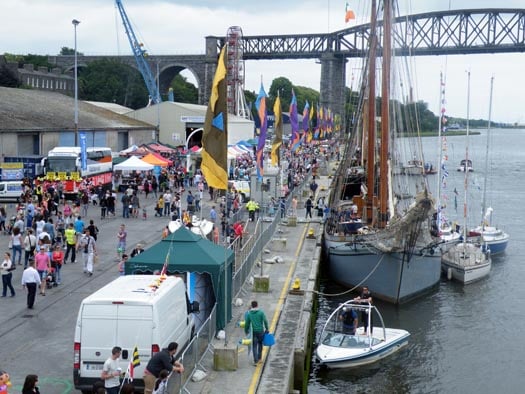
The distinctive light grey hull of ketch Irene, seen moored alongside Drogheda town quays
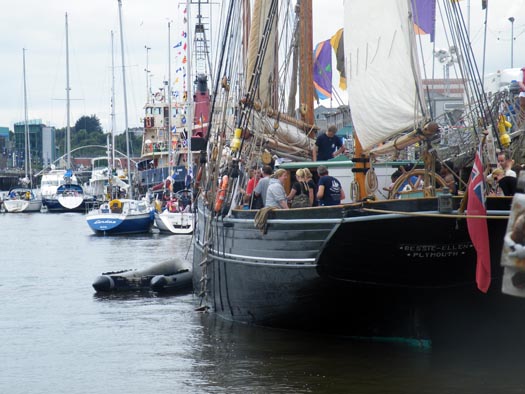
Festival-goers roam the decks of Bessie Ellen and berthed ahead the hopper dredger Hebble Sand
Arguably the most rustic of the flotilla was the gaff-ketch former trawler Keewaydin which this year celebates her 101st year on the water. She had sailed from Dun Laoghaire Harbour having departed from her last UK port in Falmouth. Berthed ahead was the former Baltic trading ketch Ruth which as previously reported anchored off Dalkey in recent weeks.
The third and final ketch caller was the light-grey hulled Irene of 1907, which took part in last year’s 'Sail Home to Your Roots' event as part of the Gathering.
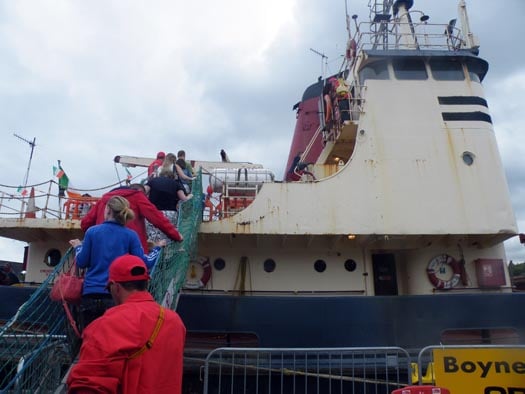
Another classic vessel, albeit without sails, the 'Hebble Sand' (pictured above) is a grab-hopper dredger built in 1963 which was made open to the public. The opportunity gave visitors a greater insight into the working operations of the 757 tonnes vessel which remains employed after more than five decades serving UK and Irish ports.
Her most recent job was carried out at the festival's host port in which Afloat.ie previously reported. The Dundalk-registered vessel is from where for many years she was based in the neighbouring Louth homeport port until sold to current owners Abco Marine.
Hop Onto the 'Hopper' at the Irish Maritime Festival
#IrishMaritimeFestival– In addition to all those tallship's at the Irish Martime Festival (13,14,15 June) in Drogheda Port, another classic vessel, 'Hebble Sand' a grab-hopper dredger built in 1963 will be open to the public.
The 757 tonne veteran at more than half a century old, has had a long and colourful working history. She is still operating having worked for more than five decades throughout Irish and UK ports. As previously reported on Afloat.ie, she is finishing a dredging campaign in Drogheda Port just in time to join the spectacle of tallships vessels on view to the public.
Access to the public of Hebble Sand, will give a real feel for a working ship and that of the operational side of port related activity. She is one of the last dredgers of its type and age, having been built in 1963 from Richard (Shipbuilders) of Lowestoft.
She was sold to Abco Marine in 2012 following her sale by Dublin Port Company, though her career in recent years had been with Dundalk Port. Almost two years ago she made her first voyage since her sale from the capital bound for the Mull of Kintyre.
Video Of Grounded Cargo Ship At Drogheda Port
#ArklowRuler - TheJournal.ie has shared this video of the cargo ship Arklow Ruler as it found itself stuck at the mouth of the River Boyne at Drogheda Port.
Thankfully the 80-metre freighter poses no immediate danger and is carrying ho hazardous cargo - though attempts to free her at high tide have so far been unsuccessful, causing much frustration for port officials and the Arklow Ruler's crew of eight.
It comes three-and-a-half years after another cargo ship from the same company, the Arklow Raider, ran around on a sandbank in the same area. The MCIB report on that incident was published in October 2012.
#tallships – The Drogheda Port Company in conjunction with Sail Training Ireland confirm the 'Spirit of Oysterhaven' will be joining the parade of classic ships at this years fun packed Maritime Festival. The 70ft–classic schooner is Ireland's only 'non-naval' Sail training vessel.
This June she will be home to the adventurous local youths selected through the 'Drogheda Tall Ships Bursary Scheme' kindly supported by local businesses. 'The scheme is now in its second year and it is providing young people with a truly unique experience of self discovery and growth, while teaching them all the elements involved in sailing' said Nessa Lally of Drogheda Port.
This year there are two voyages confirmed. The first group of aspiring sailors will leave Cork on the 9th of June and sail into Drogheda with the 2014 classic ship fleet on the 13th of June, when all this years maritime festivities will kick off. The second voyage will mark the end of the festival weekend, on the 16th of June parents will be waving their teenagers goodbye from Drogheda Port as they set sail on their thrilling 5 day adventure.
#maritimefestivals – A pirate battle on the Boyne will kick off The Irish Maritime Festival – a spectacular celebration of all things seafaring which takes place in Drogheda from June 13 to 15.
A feast of maritime fun including the Boyne Boat Race, show-stopping water sports, a Boyne swim, a maritime pavilion plus a host of cultural and family entertainment will accompany the arrival of six classic sailing ships of a bygone era to Drogheda port.
The majestic sail-powered vessels visiting the port include three ketches – the Bessie Ellen, built in 1904, the Irene, which dates from 1907, and the Keewaydin, built in 1913.
They will be joined by the 80-year-old schooner Soteria, the Baltic trader Ruth and the sail schooner Vilma.
"The Irish Maritime Festival is going to be even bigger and better than the very successful tall ships event last year which attracted over 45,000 visitors to the town," said Joan Martin, Director of Services at Drogheda Borough Council.
The event will start with a bang when a horde of buccaneering pirates re-enact a full-scale battle complete with real cannon fire, following a maritime sail parade up the Boyne.
Festivalgoers will be spoiled for choice with funfairs on the quays, boat and canoe trips on the river, stunning watersports displays, boat-building workshops, stand-up paddle boarding races and a maritime pavilion packed full of food, art, culture and kiddies fun zones.
Saturday sees another Battle of the Boyne take place as swimmers take to the river for the inaugural Boyne Swim, a 2.7 km course starting in Mell and finishing south of the Viaduct.
That day also features the Boyne Boat Race with rowing clubs from around the country taking part.
Watersport fans are in for a treat with regular world-class displays of jet skiing, water skiing, and wakeboarding plus expert demonstrations of jet-powered flyboarding.
"The festival is about giving people the chance to really enjoy the river," said Paul Fleming, CEO of Drogheda Port Company.
Onshore at Drogheda Port a revamped warehouse will be transformed into the maritime pavilion, featuring a temporary beach area and a real food village celebrating local artisan food producers, along with art, photography, maritime history and kids play zones.
The Irish Navy will be in attendance at the maritime enterprise, education and careers zone.
The Festival sees the return of the Drogheda Tall Ships bursary scheme by Drogheda Port Company and Sail Training Ireland with local young people given the chance to be part of a once-in-a-lifetime on-board sailing experience for a week.
Hosted by Drogheda Port and organised by Drogheda Borough Council, The Irish Maritime Festival has been kindly sponsored by Coca-Cola, Aura Leisure Centre, Flogas and Irish Rail.
Plans for Bremore Port Project in Deep Water
#BremorePort – It appears that plans for the proposed €350m development of the deep-water port at Bremore, near Balbriggan, Co. Dublin has been effectively shot down under the government's new ports policy blueprint.
The proposed port was to be developed to provide support for Drogheda and Dublin ports.
A government source confirmed that the new policy indicated that "there was no need for new capacity development and that any main developments should be done at Dublin, Cork or Shannon, so it's unlikely that Bremore will be progressed."
The news has been greeted as a blow to the local economy by Balbriggan Chamber of Commerce.For more on this story the NorthCountyLeader.ie has a report.
Minister Varadkar Visits Drogheda Port
#droghedaport – The Minister for Transport, Tourism and Sport Mr Leo Varadkar visited Drogheda Port this week at the Launch of Drogheda's fringe and maritime festival. Up to six tall ships will visit the Port between the 4th and 6th May 2013.



























